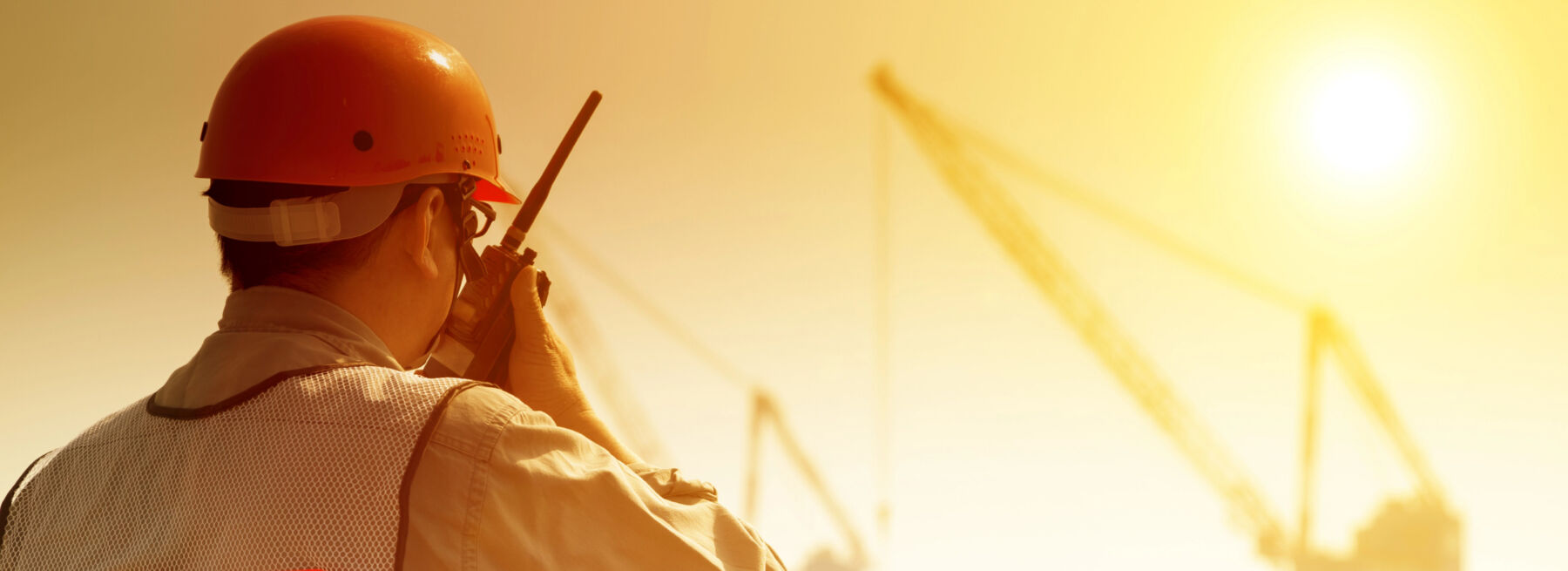Construction safety is always a priority. But the summer heat is nothing like anyone has ever experienced. CNN reported that the entire planet experienced the hottest day ever on July 21 per Copernicus, a European climate service. Copernicus has been tracking climate data since 1940.
That’s not the scary part. A representative from Copernicus says there’s a huge difference between the temperature in the last 13 months and the temperature records before that. “We are now in truly uncharted territory as the climate keeps warming, we are bound to see new records being broken in future months and years,” Copernicus Director Carlo Buontempo said in a statement.
This means construction safety during the summer months needs review. The usual recommendations may not be enough to prevent dehydration, heat stroke, and other heat-related illnesses and injuries. Heat-related illnesses are a serious problem.
What Are the Symptoms of Heat-Related Illnesses?
Last year, five local workers went to the emergency room on the hottest day of the year. They had unlimited access to water and drinks with electrolytes. Yet, they all passed out from heat exhaustion. It takes more than drinking plenty of fluids when it comes to construction safety in the heat.
Construction workers may not realize they’re close to experiencing heat exhaustion. If they don’t receive prompt treatment, then it can lead to heatstroke, which is more dangerous and requires hospitalization. Here are the symptoms of common heat-related illnesses.
Heat rash: A heat rash is a rash where the skin turns red and feels warm or prickly. Unlike a sunburn, a heat rash can occur anywhere including places covered by clothes. It’s usually in the areas where moisture is trapped. There may be tiny bumps due to the inflamed sweat glands and clogged pores on the surface of the skin. It may look like red patches and itch.
Sunburn: A sunburn is caused by overexposure to sunlight on skin that does not have proper protection. Signs include blisters on the skin and skin that’s painful, red, and warm. Construction workers should be wearing sun protection, long sleeves, and pants. Another clue to sunburn is the skin turns white when pressed. When someone experiences a sunburn, they need to get out of the sun and treat it.
Sun poisoning: People confuse sunburn and sun poisoning. They are not the same thing. Sun poisoning is a more harmful sunburn that lasts longer and comes with more severe symptoms. It’s more of an allergic reaction or illness and lasts longer than a sunburn. Symptoms of sun poisoning include severe sunburn, blisters, pain, itching, headache, nausea, vomiting, fever and chills, dizziness or lightheadedness, dehydration, fatigue, and rapid heartbeat.
Dehydration: Construction workers may not feel like they’re thirsty when they’re dehydrated. They need to watch for signs of dehydration, which include dizziness, thirst, dark-colored urine, and dry skin.
Heat cramps: These are painful involuntary muscle spasms that happen during exercise or being in a hot setting. While spasms can be anywhere on the body, the most common areas are the calves, thighs, and shoulders.
Heat exhaustion: Less dangerous than heat stroke, heat exhaustion can turn into a heat stroke if it’s not treated. It starts when the body loses excessive amounts of water and salt. Usually, this loss comes through sweating and the body is struggling to cool down. Left untreated, heat exhaustion can damage organs and systems. Symptoms include heavy sweating, fast, weak pulse, nausea or vomiting, muscle cramps, tiredness or weakness, headache, dizziness, cold, pale, and clammy skin, and passing out.
Heat stroke: Sometimes referred to as sunstroke, heat stroke is the most severe of the heat-related illnesses as it can be fatal. By the time someone has a heat stroke, they’ve stopped sweating. It’s possible to experience heat stroke without warning symptoms from heat exhaustion. Symptoms include confusion, body temperature of 103°F or higher, hot, red, dry, or damp skin, fast pulse, headache, dizziness, nausea, and passing out.
How to Prevent Heat-Related Illnesses
It’s important to know that OSHA reports almost 3 out of 4 heat illness fatalities occur in an individual’s first week of work. Therefore, it’s essential to acclimatize construction workers. This helps them build a tolerance for working in the heat. New and returning workers should gradually increase the amount of time they’re exposed to the heat elements and take more frequent breaks.
OSHA recommends workers start with 20% exposure on the first day and add 20% each day. If they start work on Monday and work daily, then they’ll reach 100% by Friday.
Create a heat-illness prevention strategy
Every construction safety plan should include a heat-illness prevention strategy. The Occupational Safety and Health Administration has a working in outdoor and indoor heat environments guide.
The guide has a template for creating a heat-illness prevention plan based on guidelines from OSHA, the National Institute for Occupational Safety and Health (NIOSH), and the American Conference of Governmental Industrial Hygienists (ACGIH).
The strategy consists of five areas of heat-illness prevention. The first is to train construction workers and managers on recognizing symptoms and heat-illness prevention strategies. The second item is to monitor weather and workplace conditions.
The third is to conduct a heat hazard assessment. The fourth is to implement heat-illness prevention strategies. And lastly, create a plan on how to handle heat-related emergencies.
OSHA and NIOSH have a free Heat Safety Tool App for iOS and Android devices. The purpose of the app is to plan outdoor work activities based on the real-time heat index and hourly forecasts for the construction site location. It also includes signs, symptoms and first aid for treating heat-related illnesses. The app is also available in Spanish.
Use high-quality PPE
Construction companies need to invest in high-quality personal protective equipment (PPE). The right PPE can protect the body from the sun while ensuring the body remains light and as cool as possible. PPE performance can be affected by heat and rain, so look for those that are outdoor-friendly and water-resistant.
Companies with the lowest rate of injuries invest in high-quality gear and provide safety training on which PPE to use for the task. It’s also important the PPE fits properly as poorly fitting gear can lead to accidents and injuries.
Monitor for heat-related symptoms
Construction workers may not self-monitor their symptoms or other people’s symptoms. While all workers may receive training on how to monitor symptoms for themselves and others, they may not pay attention as they’re focused on their tasks. This is where video surveillance with remote monitoring can help.
It also provides a simple, safe, and cost-effective way to protect the construction site from crimes, break-ins, and other problems. The high-camera views come in handy for planning and organizing a construction project. This maximizes construction safety and productivity while minimizing injuries and potential damage.
A smartly designed video surveillance system with remote monitoring puts two types of eyes — artificial intelligence and trained monitoring operators — across the construction site while recording everything that goes on. Proactive video surveillance with remote monitoring services like those from Stealth Monitoring have deterred crime.
Severe weather and record-breaking heat have become a regular occurrence. With video surveillance and remote monitoring services, AI and trained monitoring operators watch the jobsite. They’re located away from the jobsite in an air-conditioned setting. This lets them focus on watching for problems and report them ASAP.
If a problem arises, the monitoring operators can contact the jobsite and/or local authorities. The sooner someone knows about the issue and responds, the less damage could be incurred.
Train workers on general heat safety tips
Heat-related illnesses can easily be avoided by applying these safety tips.
Hydrate: Drink plenty of water and electrolytes. Sports drinks contain electrolytes, which are electronically conducive ions. Electrolytes are essential minerals in blood, sweat, and urine, which help the body’s processes.
Electrolytes in the body include sodium, potassium, chloride, calcium, magnesium, phosphate, and bicarbonate. Drinking electrolytes ensures the nerve and muscle functions work properly and keeps the person hydrated.
Dress properly: Construction workers need to wear light-colored and loose-fitting clothing. These prevent absorbing the sun’s light and trapping heat. While hats can shield faces from the sun, be careful because they can trap too much heat.
Take breaks: It’s vital to construction safety to allow for regular breaks during the hottest days. Workers must have a place to go to cool down when they notice signs of heat exhaustion. Consider stagnating the breaks to ensure there’s always someone doing the task. They should take breaks in an area with cool air like a trailer or another space with shade, fans, and water misters.
Protect the Construction Site Assets and Workers
Construction companies are responsible for everyone’s safety on the site. With days growing hotter and lasting longer, they need multiple tactics to prevent heat-related illnesses and help deter theft.
For a deeper dive into this topic, check out the construction security and safety best practices guide. This guide covers construction site challenges and suggests solutions. It includes construction industry best practices to set up more secure and safer construction sites. If you’d like to learn more, feel free to contact us.
Want to learn more about construction site security? Get our complete guide to construction site safety and security solutions. Planning and organizing your construction project can help maximize construction safety and efficiency while minimizing injuries and worksite damage.
Texas Private Security License Number: B14187
California Alarm Operator License Number: ACO7876
Florida Alarm System Contractor I License Number: EF20001598
Tennessee Alarm Contracting Company License Number: 2294
Virginia Private Security Services Business License Number: 11-19499
Alabama Electronic Security License # 002116
Canada TSBC License: LEL0200704

